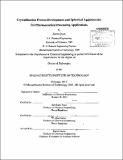| dc.contributor.advisor | Bernhardt Trout and T. Alan Hatton. | en_US |
| dc.contributor.author | Quon, Justin (Justin Louie) | en_US |
| dc.contributor.other | Massachusetts Institute of Technology. Department of Chemical Engineering. | en_US |
| dc.date.accessioned | 2013-06-17T19:56:09Z | |
| dc.date.available | 2013-06-17T19:56:09Z | |
| dc.date.copyright | 2013 | en_US |
| dc.date.issued | 2013 | en_US |
| dc.identifier.uri | http://hdl.handle.net/1721.1/79322 | |
| dc.description | Thesis (Ph. D.)--Massachusetts Institute of Technology, Dept. of Chemical Engineering, 2013. | en_US |
| dc.description | Cataloged from PDF version of thesis. | en_US |
| dc.description | Includes bibliographical references (p. 102-107). | en_US |
| dc.description.abstract | The control of crystallization steps is essential in the production of many materials in the pharmaceutical, materials, and chemical industries. Additionally, due to increasing costs of research and development, reductions in manufacturing costs by moving from batch to continuous manufacturing are necessary to sustain profitability of the pharmaceutical industry. Two different projects were researched to progress towards this goal. The first was the demonstration of a continuous manufacturing platform. The second goal was the development of new crystallization techniques. Two continuous crystallization processes were developed as part of a demonstration unit for continuous manufacturing of Aliskiren hemifumarate. The first process was an anti-solvent crystallization of an intermediate. The second process was a continuous reactive crystallization developed for the final product. The processes were able to crystallize the two compounds with both high yield (>90%) and purity (>99%). Population balance modeling was performed and experimental data were fit to the model to obtain kinetic parameters for crystal growth and nucleation for both systems. The models were used to optimize crystal purity and yield of the products. In addition, this thesis describes two separate projects involving spherical agglomerates. In the first study, acetaminophen was shown to crystallize significantly faster in the presence of spherical agglomerates of lactose than single crystal lactose. An epitaxy study and molecular dynamics simulations showed that the (141̄)/(001) pairing of faces showed coincident lattice matching and favorable energy interaction. Maximizing the number of substrate faces available for interaction increases the chance for a lattice match between the substrate and the crystallizing material which can be useful for controlling and increasing nucleation kinetics. Finally, water-in-oil emulsions were used to make composite spherical agglomerates with two components: a heterosurface, and a target compound that does not typically crystallize as spherical agglomerates on its own. The generated composite agglomerates were relatively monodisperse and were characterized using optical microscopy, scanning electron microscopy, x-ray powder diffraction, and differential scanning calorimetry. This technique could potentially be applied to other hydrophilic compounds, in particular water-soluble pharmaceuticals compounds, in order to change crystal morphology to spherical agglomerates in order to simplify downstream processing. | en_US |
| dc.description.statementofresponsibility | by Justin Quon. | en_US |
| dc.format.extent | 107 p. | en_US |
| dc.language.iso | eng | en_US |
| dc.publisher | Massachusetts Institute of Technology | en_US |
| dc.rights | M.I.T. theses are protected by
copyright. They may be viewed from this source for any purpose, but
reproduction or distribution in any format is prohibited without written
permission. See provided URL for inquiries about permission. | en_US |
| dc.rights.uri | http://dspace.mit.edu/handle/1721.1/7582 | en_US |
| dc.subject | Chemical Engineering. | en_US |
| dc.title | Crystallization process development and spherical agglomerates for pharmaceutical processing applications | en_US |
| dc.type | Thesis | en_US |
| dc.description.degree | Ph.D. | en_US |
| dc.contributor.department | Massachusetts Institute of Technology. Department of Chemical Engineering | |
| dc.identifier.oclc | 844351108 | en_US |
